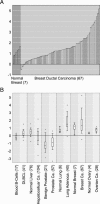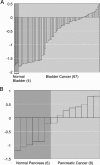ONCOMINE: a cancer microarray database and integrated data-mining platform
- PMID: 15068665
- PMCID: PMC1635162
- DOI: 10.1016/s1476-5586(04)80047-2
ONCOMINE: a cancer microarray database and integrated data-mining platform
Abstract
DNA microarray technology has led to an explosion of oncogenomic analyses, generating a wealth of data and uncovering the complex gene expression patterns of cancer. Unfortunately, due to the lack of a unifying bioinformatic resource, the majority of these data sit stagnant and disjointed following publication, massively underutilized by the cancer research community. Here, we present ONCOMINE, a cancer microarray database and web-based data-mining platform aimed at facilitating discovery from genome-wide expression analyses. To date, ONCOMINE contains 65 gene expression datasets comprising nearly 48 million gene expression measurements form over 4700 microarray experiments. Differential expression analyses comparing most major types of cancer with respective normal tissues as well as a variety of cancer subtypes and clinical-based and pathology-based analyses are available for exploration. Data can be queried and visualized for a selected gene across all analyses or for multiple genes in a selected analysis. Furthermore, gene sets can be limited to clinically important annotations including secreted, kinase, membrane, and known gene-drug target pairs to facilitate the discovery of novel biomarkers and therapeutic targets.
Figures



Similar articles
-
Rembrandt: helping personalized medicine become a reality through integrative translational research.Mol Cancer Res. 2009 Feb;7(2):157-67. doi: 10.1158/1541-7786.MCR-08-0435. Epub 2009 Feb 10. Mol Cancer Res. 2009. PMID: 19208739 Free PMC article.
-
Gene Aging Nexus: a web database and data mining platform for microarray data on aging.Nucleic Acids Res. 2007 Jan;35(Database issue):D756-9. doi: 10.1093/nar/gkl798. Epub 2006 Nov 7. Nucleic Acids Res. 2007. PMID: 17090592 Free PMC article.
-
Hepamine - A Liver Disease Microarray Database, Visualization Platform and Data-Mining Resource.Sci Rep. 2020 Mar 16;10(1):4760. doi: 10.1038/s41598-020-61508-y. Sci Rep. 2020. PMID: 32179762 Free PMC article.
-
Bioinformatics strategies for translating genome-wide expression analyses into clinically useful cancer markers.Ann N Y Acad Sci. 2004 May;1020:32-40. doi: 10.1196/annals.1310.005. Ann N Y Acad Sci. 2004. PMID: 15208181 Review.
-
Microarray analysis of gene expression: considerations in data mining and statistical treatment.Physiol Genomics. 2006 May 16;25(3):355-63. doi: 10.1152/physiolgenomics.00314.2004. Epub 2006 Mar 22. Physiol Genomics. 2006. PMID: 16554544 Review.
Cited by
-
RasGRP1 opposes proliferative EGFR-SOS1-Ras signals and restricts intestinal epithelial cell growth.Nat Cell Biol. 2015 Jun;17(6):804-15. doi: 10.1038/ncb3175. Epub 2015 May 25. Nat Cell Biol. 2015. PMID: 26005835 Free PMC article.
-
Abnormal expression and prognostic significance of EPB41L1 in kidney renal clear cell carcinoma based on data mining.Cancer Cell Int. 2020 Jul 30;20:356. doi: 10.1186/s12935-020-01449-8. eCollection 2020. Cancer Cell Int. 2020. PMID: 32760223 Free PMC article.
-
The targets of aspirin in bladder cancer: bioinformatics analysis.BMC Urol. 2022 Oct 31;22(1):168. doi: 10.1186/s12894-022-01119-z. BMC Urol. 2022. PMID: 36316768 Free PMC article.
-
Expression pattern of histone lysine-specific demethylase 6B in gastric cancer.Oncol Lett. 2021 Jun;21(6):491. doi: 10.3892/ol.2021.12752. Epub 2021 Apr 26. Oncol Lett. 2021. PMID: 33968207 Free PMC article.
-
Activation of NQO1 in NQO1*2 polymorphic human leukemic HL-60 cells by diet-derived sulforaphane.Exp Hematol Oncol. 2016 Sep 13;5(1):27. doi: 10.1186/s40164-016-0056-z. eCollection 2015. Exp Hematol Oncol. 2016. PMID: 27625902 Free PMC article.
References
-
- Alizadeh AA, Eisen MB, Davis RE, Lossos IS, Rosenwald A, Boldrick JC, Sabet H, Tran T, Yu X, et al. Distinct types of diffuse large B-cell lymphoma identified by gene expression profiling. Nature. 2000;403:503–511. - PubMed
-
- Beer DG, Kardia SL, Huang CC, Giordano TJ, Levin AM, Misek DE, Lin L, Chen G, Gharib TG, Thomas DG, et al. Gene-expression profiles predict survival of patients with lung adenocarcinoma. Nat Med. 2002;8:816–824. - PubMed
Publication types
MeSH terms
Grants and funding
LinkOut - more resources
Full Text Sources
Other Literature Sources
